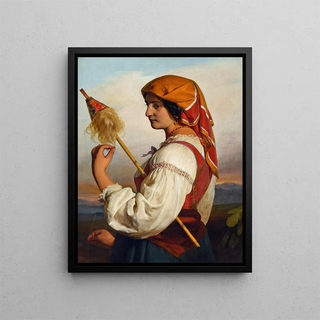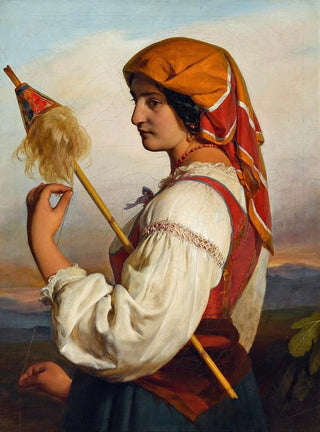Italian Chiaruccia with distaff - Friedrich von Amerling


View from behind

Frame (optional)
In the enchanting world of art, some works manage to transcend time and capture the very essence of humanity. The art print of the Italian Chiaruccia with distaff - Friedrich von Amerling falls into this category. This painting, emblematic of the 19th century, evokes timeless beauty and rare delicacy. Through the penetrating gaze of the young woman, seemingly frozen in a moment of contemplation, the artist invites us to explore the subtleties of the feminine soul, while immersing us in a setting rich in colors and textures. Light plays a fundamental role in this piece, illuminating the features of the model and creating an almost mystical atmosphere.
Style and uniqueness of the work
Friedrich von Amerling's style is characterized by striking realism, combined with romantic sensitivity. In the art print of the Italian Chiaruccia with distaff, the artist employs a palette of soft, harmonious colors that confer unparalleled gentleness and voluptuousness to the scene. The meticulous details, such as the delicate folds of the young woman's clothing and the texture of the distaff, demonstrate exceptional technical mastery. Amerling excels in rendering light, creating subtle reflections that bring the canvas to life. This work does not merely depict a female figure; it tells a story, a world where each element dialogues with the other. The posture of the young woman, both natural and graceful, embodies the ideal of classical beauty while suggesting deep introspection.
The artist and his influence
Friedrich von Amerling, born in 1803 in Vienna, is recognized as one of the most talented portraitists of his time. His career spanned several decades, during which he captured the essence of his contemporaries with remarkable precision and sensitivity. Influenced by the artistic currents of his era, Amerling developed a distinctive style that combines realism and romanticism. His works, often populated with female figures, testify to a fascination with beauty and grace. Beyond his technique, the artist also

Matte finish

View from behind

Frame (optional)
In the enchanting world of art, some works manage to transcend time and capture the very essence of humanity. The art print of the Italian Chiaruccia with distaff - Friedrich von Amerling falls into this category. This painting, emblematic of the 19th century, evokes timeless beauty and rare delicacy. Through the penetrating gaze of the young woman, seemingly frozen in a moment of contemplation, the artist invites us to explore the subtleties of the feminine soul, while immersing us in a setting rich in colors and textures. Light plays a fundamental role in this piece, illuminating the features of the model and creating an almost mystical atmosphere.
Style and uniqueness of the work
Friedrich von Amerling's style is characterized by striking realism, combined with romantic sensitivity. In the art print of the Italian Chiaruccia with distaff, the artist employs a palette of soft, harmonious colors that confer unparalleled gentleness and voluptuousness to the scene. The meticulous details, such as the delicate folds of the young woman's clothing and the texture of the distaff, demonstrate exceptional technical mastery. Amerling excels in rendering light, creating subtle reflections that bring the canvas to life. This work does not merely depict a female figure; it tells a story, a world where each element dialogues with the other. The posture of the young woman, both natural and graceful, embodies the ideal of classical beauty while suggesting deep introspection.
The artist and his influence
Friedrich von Amerling, born in 1803 in Vienna, is recognized as one of the most talented portraitists of his time. His career spanned several decades, during which he captured the essence of his contemporaries with remarkable precision and sensitivity. Influenced by the artistic currents of his era, Amerling developed a distinctive style that combines realism and romanticism. His works, often populated with female figures, testify to a fascination with beauty and grace. Beyond his technique, the artist also






